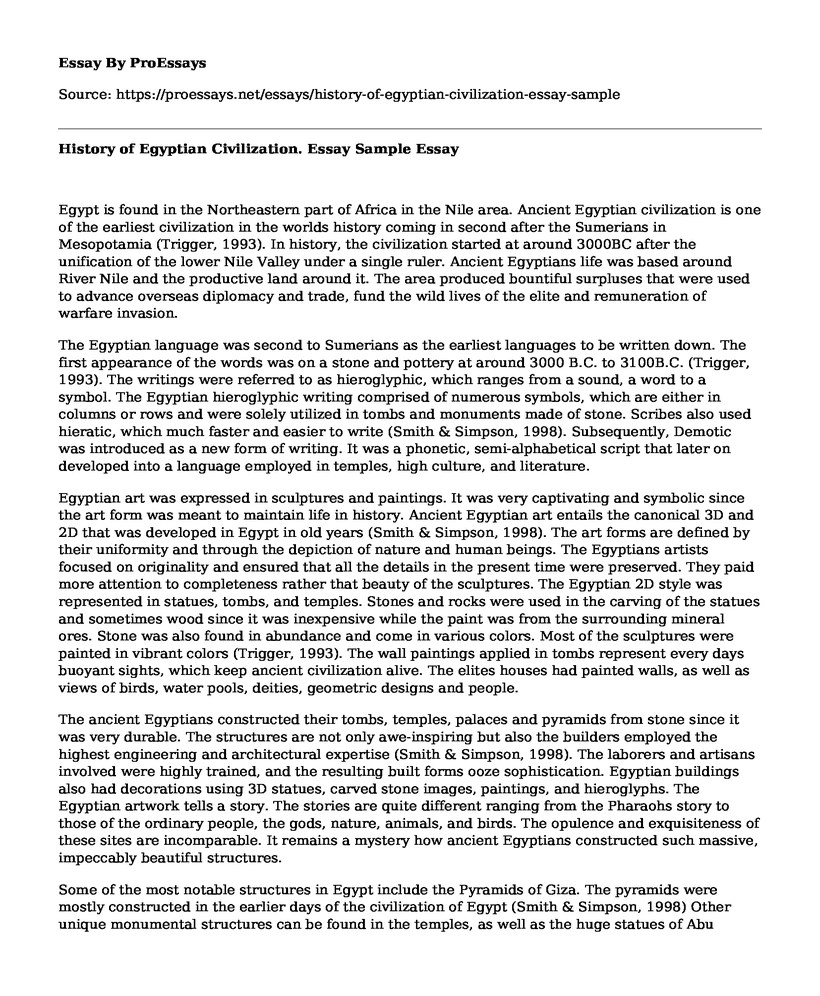Egypt is found in the Northeastern part of Africa in the Nile area. Ancient Egyptian civilization is one of the earliest civilization in the worlds history coming in second after the Sumerians in Mesopotamia (Trigger, 1993). In history, the civilization started at around 3000BC after the unification of the lower Nile Valley under a single ruler. Ancient Egyptians life was based around River Nile and the productive land around it. The area produced bountiful surpluses that were used to advance overseas diplomacy and trade, fund the wild lives of the elite and remuneration of warfare invasion.
The Egyptian language was second to Sumerians as the earliest languages to be written down. The first appearance of the words was on a stone and pottery at around 3000 B.C. to 3100B.C. (Trigger, 1993). The writings were referred to as hieroglyphic, which ranges from a sound, a word to a symbol. The Egyptian hieroglyphic writing comprised of numerous symbols, which are either in columns or rows and were solely utilized in tombs and monuments made of stone. Scribes also used hieratic, which much faster and easier to write (Smith & Simpson, 1998). Subsequently, Demotic was introduced as a new form of writing. It was a phonetic, semi-alphabetical script that later on developed into a language employed in temples, high culture, and literature.
Egyptian art was expressed in sculptures and paintings. It was very captivating and symbolic since the art form was meant to maintain life in history. Ancient Egyptian art entails the canonical 3D and 2D that was developed in Egypt in old years (Smith & Simpson, 1998). The art forms are defined by their uniformity and through the depiction of nature and human beings. The Egyptians artists focused on originality and ensured that all the details in the present time were preserved. They paid more attention to completeness rather that beauty of the sculptures. The Egyptian 2D style was represented in statues, tombs, and temples. Stones and rocks were used in the carving of the statues and sometimes wood since it was inexpensive while the paint was from the surrounding mineral ores. Stone was also found in abundance and come in various colors. Most of the sculptures were painted in vibrant colors (Trigger, 1993). The wall paintings applied in tombs represent every days buoyant sights, which keep ancient civilization alive. The elites houses had painted walls, as well as views of birds, water pools, deities, geometric designs and people.
The ancient Egyptians constructed their tombs, temples, palaces and pyramids from stone since it was very durable. The structures are not only awe-inspiring but also the builders employed the highest engineering and architectural expertise (Smith & Simpson, 1998). The laborers and artisans involved were highly trained, and the resulting built forms ooze sophistication. Egyptian buildings also had decorations using 3D statues, carved stone images, paintings, and hieroglyphs. The Egyptian artwork tells a story. The stories are quite different ranging from the Pharaohs story to those of the ordinary people, the gods, nature, animals, and birds. The opulence and exquisiteness of these sites are incomparable. It remains a mystery how ancient Egyptians constructed such massive, impeccably beautiful structures.
Some of the most notable structures in Egypt include the Pyramids of Giza. The pyramids were mostly constructed in the earlier days of the civilization of Egypt (Smith & Simpson, 1998) Other unique monumental structures can be found in the temples, as well as the huge statues of Abu Simbel and the Valley of the Kings. The elites mansions were beautifully decorated, constructed around courtyards and had painted wall while the average to poor Egyptians lived in a modest wood, mud or brick house.
Egyptian civilization resulted into some of the most beautiful art and architectural work in history. The build forms, as well as the artwork demonstrated throughout ancient Egyptian civilization, is incomprehensible and equally inspiring.
References
Smith, W. S., & Simpson, W. K. (1998). The Art and Architecture of Ancient Egypt (Vol. 14). Yale University Press.
Trigger, B. G. (1993). Early Civilizations: Ancient Egypt in Context. American Univ in Cairo Press.
Cite this page
History of Egyptian Civilization. Essay Sample. (2021, Apr 01). Retrieved from https://proessays.net/essays/history-of-egyptian-civilization-essay-sample
If you are the original author of this essay and no longer wish to have it published on the ProEssays website, please click below to request its removal:
- Essay Sample on The Cherokee Indians
- Paper Example on 70s: Rapid Change in Society: A Look at 4 Articles
- Essay Sample on Admiral Chester Nimitz: Commander in Chief of the US Pacific Fleet
- Essay Example on Operation Barbarossa: Nazi Germany's Annihilation of the Soviet Union
- The Thirty Years' War: Europe's Brutal Religious Conflict - Essay Sample
- U.S. Led Global Monetary Order: Cooperation for Peace & Prosperity - Essay Sample
- Essay Example on Michael Faraday: 19th Century Chemist & Physicist







